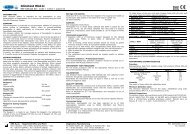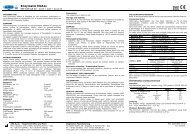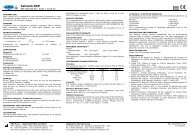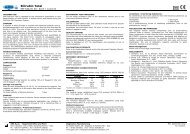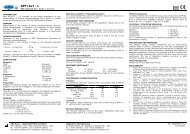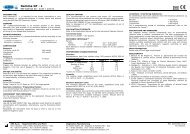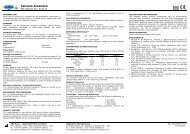Triglycerides - L - Gdsrl.com
Triglycerides - L - Gdsrl.com
Triglycerides - L - Gdsrl.com
Create successful ePaper yourself
Turn your PDF publications into a flip-book with our unique Google optimized e-Paper software.
<strong>Triglycerides</strong> - L<br />
REF SA4815 00 - 6x45 ml<br />
INTENDED USE<br />
AMS <strong>Triglycerides</strong> - L is intended for the enzymatic colorimetric<br />
quantitative in vitro determination of triglycerides in human serum and<br />
plasma using the AMS Sat-450 Chemistry System.<br />
SUMMARY<br />
<strong>Triglycerides</strong> determination is used for the diagnosis and monitoring of<br />
lipidic dysfunction for the evaluation risk of the atherosclerotic disease.<br />
Recent studies have demonstrated that high levels of triglycerides,<br />
ac<strong>com</strong>panied to an increase of low density lipoproteins (LDL), constitute<br />
a particular elevated risk for "coronary heart disease" (CHD). High<br />
triglycerides concentrations are present in several kidney, liver and<br />
pancreas diseases.<br />
METHOD PRINCIPLE<br />
Glycerol, released from triglycerides after hydrolysis with<br />
lipoproteinlipase, is transformed by glycerolkinase into glycerol-3phosphate<br />
which is oxidized by glycerolphaphate oxidase into<br />
dihydroxyacetone phosphate and hydrogen peroxide. In presence of<br />
peroxidase, the hydrogen peroxide oxidizes the chromogen ESPT (4aminophenazone/N-ethyl-methylanilin-propan-sulphonate<br />
sodic) to<br />
form purple quinoneimine whose colour intensity, measured at 550 nm,<br />
is proportional to the concentration of triglycerides in the sample.<br />
LPL<br />
<strong>Triglycerides</strong><br />
Glycerol + Fatty acids<br />
Glycerol + ATP<br />
Glycerol-3-phosphate + O2<br />
2 H2O2 + Amminoantipirine<br />
+ ESPT<br />
COMPOSITION<br />
GK<br />
GPO<br />
POD<br />
Glycerol-3-phosphate + ADP<br />
Dihydroxyacetone phosphate<br />
+ H2O2<br />
Quinoneimine + HCl + 4 H2O<br />
Reagent 1<br />
Good Buffer pH 7.2 50 mmol/l<br />
ESPT 4 mmol/l<br />
ATP 2 mmol/l<br />
Mg ++<br />
2 mmol/l<br />
Lipoproteinlipase (LPL) ≥ 1 kU/l<br />
Glycerol kinase (GK) ≥ 0.4 kU/l<br />
Glycerolphosphate oxidase (GPO) ≥ 1.5 kU/l<br />
4-Amminoantipirine 0.5 mmol/l<br />
Peroxidase (POD) >1 kU/l<br />
NaN3 < 0.095 g/l<br />
Preparation<br />
The reagent is ready to use.<br />
Storage and stability<br />
Store at 2-8 °C. Do not freeze the reagents! The reagents are stable up<br />
to the expiry date stated on the label when kept in closed vial.<br />
On board stability: 30 days<br />
SAMPLES<br />
Serum, heparin or EDTA plasma. Samples may be stored for 7 days at<br />
2-8°C or 12 months at -20 °C.<br />
Specimen collection / Preanalytical factors<br />
It is re<strong>com</strong>mended that specimen collection should be carried out in<br />
accordance with NCCLS protocol H11-A3.<br />
INSTRUMENT TEST PROCEDURE<br />
For the assay procedure refer to the Application Manual and to the<br />
instrument Operator Manual.<br />
CALIBRATION<br />
Use GD-Cal (REF GD8577 00). See calibrator insert sheet for lot specific<br />
concentration and traceability.<br />
Recalibrate the instrument every 30 days or when a new lot or new<br />
bottle of reagent is used.<br />
QUALITY CONTROL<br />
It is re<strong>com</strong>mended to use controls with known triglycerides<br />
concentration. Check that the values obtained are within the reference<br />
range provided.<br />
Normal and abnormal controls such as GD-Norm (REF GD8580 00) and<br />
GD-Path (REF GD8582 00) are re<strong>com</strong>mended.<br />
Refer to Westgard et al. (3) for identification and resolution of out of<br />
control situations.<br />
CALCULATION OF RESULTS<br />
Refer to the Application Manual and to the instrument Operator Manual.<br />
Conversion factor<br />
<strong>Triglycerides</strong> [mg/dl] x 0,01129 = <strong>Triglycerides</strong> [mmol/l].<br />
REFERENCE INTERVALS (1)<br />
Serum:<br />
Males/Females: 50 - 175 mg/dl 0,56 - 1,98 mmol/l<br />
Each laboratory should establish reference ranges for its own patients<br />
population.<br />
PERFORMANCE CHARACTERISTICS<br />
Precision<br />
Representative data from studies using CLSI protocol NCCLS EP5-A2<br />
are summarized below.<br />
Control Level 1 Level 2<br />
Number of Observations N 60 60<br />
Number of Runs N 20 20<br />
Mean mg/dl 163 301<br />
Within Run %CV 1,7 1,7<br />
Total %CV 3,4 3,4<br />
Linearity<br />
The linearity range, established using CLSI protocol NCCLS EP6-A is<br />
4 - 841 mg/dl (0,05 - 9,49 mmol/l).<br />
Minimum Detection Limit<br />
The minimum detection limit for the assay, established using CLSI<br />
protocol NCCLS EP17-A, is 4 mg/dl (0,05 mmol/l).<br />
Method Comparison<br />
Correlation studies were performed using CLSI protocol NCCLS EP9-A2.<br />
Serum results from this assay on Sat-450 were <strong>com</strong>pared with those<br />
from a <strong>com</strong>mercially available analogous system. Results were as<br />
follows: N = 60, y = 0,915x + 4,64 mg/dl, r = 0,998.<br />
AMS S.p.A. – Registered Office and Plant Diagnostics Manufacturing<br />
Via E. Barsanti 17/A | 00012 Guidonia (Rome) – Italy Via Galileo Galilei, 38 | Seggiano di Pioltello (MI) - Italy<br />
Ph. +39 0774 354441 | Fax +39 0774 578035 Ph. +39 02 929189.1 | Fax +39 02 929189.39<br />
www.ams-analyzers.<strong>com</strong> | info@ams-analyzers.<strong>com</strong> www.gdsrl.<strong>com</strong> | infodiagnostics@ams-analyzers.<strong>com</strong><br />
Limitations / Interfering Substances<br />
No interferences have been observed from the following substances up<br />
to the below reported concentration:<br />
Bilirubin > 40 mg/dl<br />
Hemoglobin > 250 mg/dl<br />
Ascorbic acid > 6 mg/dl<br />
For a <strong>com</strong>prehensive review of interfering substances, refer to the<br />
publication by Young (2) .<br />
PRECAUTIONS AND WARNINGS<br />
The reagents contain inactive <strong>com</strong>ponents such as preservatives<br />
(Sodium azide or others), surfactants etc. The total concentration of<br />
these <strong>com</strong>ponents is lower than the limits reported by 67/548/EEC and<br />
88/379/EEC directives about classification, packaging and labelling of<br />
dangerous substances. However, the reagents should be handled with<br />
caution, avoiding swallowing and contact with skin, eyes and mucous<br />
membranes. The use of laboratory reagents according to good<br />
laboratory practice is re<strong>com</strong>mended.<br />
Waste Management<br />
Please refer to local legal requirements.<br />
BIBLIOGRAPHY<br />
1. Besozzi M, De Angelis G., Franzini C: Espressione dei risultati nel<br />
laboratorio di chimica clinica. Società Italiana di Biochimica Clinica<br />
(SIBioC).<br />
2. Young D.S., Effects of Drugs on Clinical Laboratory Tests, AACC<br />
Press, Washington, D.C., 1990.<br />
3. Westgard J., and Barry P., Cost- Effective Quality Control: Managing<br />
the Quality and Productivity of Analytical Processes, AACC Press,<br />
Washington, D.C., 1986.<br />
4. Rifai N, Bachorik PS, Albers JJ. Lipids, lipoproteins and<br />
apolipoproteins. In: Burtis CA, Ashwood ER, editors. Tietz Textbook<br />
of Clinical Chemistry. 3rd ed. Philadelphia: W.B Saunders Company;<br />
1999. p. 809-61.<br />
5. Cole TG, Klotzsch SG, McNamara J: Measurement of triglyceride<br />
concentration. In: Rifai N, Warnick GR, Dominiczak MH, eds.<br />
Handbook of lipoprotein testing. Washington: AACC Press, 1997.<br />
p.115-26.<br />
6. Re<strong>com</strong>mendation of the Second Joint Task Force of European and<br />
other Societies on Coronary Prevention. Prevention of coronary heart<br />
disease in clinical practice. Eur Heart J 1998; 19: 1434-503.<br />
7. Chitto G, Fabi A, Franzini C, Galletta G, Leonardi A, Marelli M, Morelli<br />
AM: Variabilità biologica intra-individuo: rassegna della letteratura,<br />
contributo sperimentale e considerazioni critiche. Biochimica Clinica,<br />
1994; 18, 10:673.<br />
8. NCCLS Document, “Procedures for the collection of arterial blood<br />
specimens”, Approved Standard, 3rd Ed. (1999).<br />
9. EU-Dir 1999/11 Commission Directive of 8 March 1999 adapting to<br />
technical progress the principles of good laboratory practice as<br />
specified in Council Directive 87/18/EEC…NCCLS Document,<br />
“Procedures for the collection of arterial blood specimens”, Approved<br />
Standard, 3rd Ed. (1999).<br />
Met. SA481500.0 Eng<br />
Ed. 09/2012
Trigliceridi - L<br />
REF SA4815 00 - 6x45 ml<br />
USO<br />
Il kit AMS Trigliceridi - L viene impiegato per la determinazione<br />
enzimatica colorimetrica quantitativa in vitro dei trigliceridi nel siero e<br />
plasma umano con sistema AMS Sat-450.<br />
SOMMARIO<br />
La determinazione dei trigliceridi è utilizzata nella diagnosi e nel<br />
monitoraggio delle disfunzioni lipidiche per la valutazione dei rischi di<br />
malattia aterosclerotica. Studi recenti hanno dimostrato che alte<br />
concentrazioni di trigliceridi, <strong>com</strong>binate con un aumento delle<br />
lipoproteine a bassa densità (LDL) costituiscono un rischio<br />
particolarmente elevato per la malattia coronarica (“coronary heart<br />
disease”, CHD). Alti livelli di trigliceridi sono presenti anche in varie<br />
malattie del fegato, dei reni e del pancreas.<br />
PRINCIPIO<br />
Il glicerolo, ottenuto dall’idrolisi dei trigliceridi da parte della<br />
lipoproteinlipasi, è trasformato dalla glicerochinasi in glicerolo-3-fosfato<br />
il quale è ossidato dalla glicerolo-3-fosfato-ossidasi in diidrossiacetone<br />
fosfato e perossido d’idrogeno. In presenza della perossidasi il<br />
perossido d’idrogeno ossida il cromogeno ESPT (4-aminofenazone/Netil-metilanilin-propan-solfonato<br />
sodico) formando il <strong>com</strong>posto rosso<br />
chinonimina la cui intensità di colore, misurata spettrofotometricamente<br />
a 550 nm, è proporzionale alla concentrazione dei trigliceridi presenti<br />
nel campione.<br />
LPL<br />
Trigliceridi<br />
Glicerolo + Acidi grassi<br />
Glicerolo + ATP<br />
Glicerolo-3-fosfato + O2<br />
2 H2O2 + Amminoantipirina<br />
+ ESPT<br />
COMPOSIZIONE<br />
GK<br />
GPO<br />
POD<br />
Glicerolo-3-fosfato + ADP<br />
Diidrossiacetone fosfato +<br />
H2O2<br />
Chinonimina + HCl + 4 H2O<br />
Reagente 1<br />
Tampone di Good pH 7.2 50 mmol/l<br />
ESPT 4 mmol/l<br />
ATP 2 mmol/l<br />
Mg ++<br />
2 mmol/l<br />
Lipoproteinlipasi (LPL) ≥ 1 kU/l<br />
Glicerochinasi (GK) ≥ 0.4 kU/l<br />
Glicerolo-fostato-ossidasi (GPO) ≥ 1.5 kU/l<br />
4-Amminoantipirina 0.5 mmol/l<br />
Perossidasi (POD) >1 kU/l<br />
NaN3 < 0.095 g/l<br />
Preparazione<br />
Il reagente è pronto all’uso.<br />
Conservazione e Stabilità<br />
Conservare a 2-8 °C. Non congelare i reattivi! I reattivi sono stabili fino<br />
alla data di scadenza riportata in etichetta, se conservati in flacone<br />
chiuso.<br />
Stabilità a bordo dello strumento: 30 giorni<br />
CAMPIONI<br />
Siero, Plasma EDTA o eparina: I campioni possono essere conservati<br />
per 7 giorni a 2-8°C o 12 mesi a -20 °C.<br />
Raccolta dei Campioni / Fattori Preanalitici<br />
Si rac<strong>com</strong>anda di effettuare la raccolta dei campioni in conformità al<br />
Protocollo NCCLS H11-A3.<br />
PROCEDURA DI ANALISI<br />
Per la procedura di analisi fare riferimento all’Application Manual e al<br />
Manuale dell’Operatore dello strumento.<br />
CALIBRAZIONE<br />
Utilizzare GD-Cal (REF GD8577 00). Riferirsi all’inserto del calibratore<br />
per la concentrazione specifica del lotto e la tracciabilità.<br />
Ricalibrare lo strumento ogni 30 giorni o quando viene utilizzato un<br />
nuovo lotto o una nuova bottiglia di reagente.<br />
CONTROLLO DI QUALITA’<br />
Si rac<strong>com</strong>anda l’uso di controlli a titolo noto di trigliceridi. Verificare che<br />
il valore ottenuto sia all’interno degli intervalli di accettabilità forniti. Si<br />
consiglia l’uso di controlli Normale e Patologico <strong>com</strong>e GD-Norm (REF<br />
GD8580 00) e GD-Path (REF GD8582 00).<br />
Far riferimento a Westgard et al. (3) per l’identificazione e la risoluzione<br />
di problematiche legate ai controlli fuori dai limiti.<br />
CALCOLO DEI RISULTATI<br />
Riferirsi all’Application Manual e al Manuale dell’Operatore dello<br />
strumento.<br />
Fattori di Conversione<br />
Trigliceridi [mg/dl] x 0,01129 = Trigliceridi [mmol/l].<br />
INTERVALLO DI RIFERIMENTO (1)<br />
Siero:<br />
Uomini/Donne: 50 - 175 mg/dl 0,56 - 1,98 mmol/l<br />
Si rac<strong>com</strong>anda ad ogni laboratorio di stabilire i propri valori normali in<br />
funzione della popolazione su cui opera.<br />
PRESTAZIONI ANALITICHE<br />
Precisione<br />
Dati rappresentativi dello studio secondo il protocollo CLSI NCCLS<br />
EP5-A2 sono sotto riportati.<br />
Controllo Livello 1 Livello 2<br />
Numero di Osservazioni N 60 60<br />
Numero di Prove N 20 20<br />
Media mg/dl 163 301<br />
Nella Corsa %CV 1,7 1,7<br />
Totale %CV 3,4 3,4<br />
Linearità<br />
L’intervallo di linearità, stabilito tramite il protocollo CLSI NCCLS EP6-A<br />
è risultato pari a 4 - 841 mg/dl (0,05 - 9,41 mmol/l).<br />
Limite Minimo di Rivelabilità<br />
Il limite minimo di rilevabilità, stabilito tramite il protocollo CLSI NCCLS<br />
EP17-A, è 4 mg/dl (0,05 mmol/l).<br />
AMS S.p.A. – Sede Legale e Stabilimento Produzione Diagnostici<br />
Via E. Barsanti 17/A | 00012 Guidonia (Roma) – Italia Via Galileo Galilei, 38 | Seggiano di Pioltello (MI) - Italia<br />
Tel. +39 0774 354441 | Fax +39 0774 578035 Tel. +39 02 929189.1 | Fax +39 02 929189.39<br />
www.ams-analyzers.<strong>com</strong> | info@ams-analyzers.<strong>com</strong> www.gdsrl.<strong>com</strong> | infodiagnostics@ams-analyzers.<strong>com</strong><br />
Comparazione fra Metodi<br />
Studi di correlazione sono stati effettuati secondo il protocollo CLSI<br />
NCCLS EP9-A2. I risultati dei sieri di questo dosaggio su Sat-450 sono<br />
stati confrontati con un sistema analogo presente in <strong>com</strong>mercio. I<br />
risultati sono stati i seguenti: N = 60, y = 0,915x + 4,64 mg/dl, r =<br />
0,998.<br />
Limitazioni / Sostanze Interferenti<br />
Nessuna interferenza è stata osservata dalle seguenti sostanze fino alla<br />
concentrazione sotto indicata:<br />
Bilirubina > 40 mg/dl<br />
Emoglobina > 250 mg/dl<br />
Acido Ascorbico > 6 mg/dl<br />
Per una panoramica <strong>com</strong>pleta sulle sostanze interferenti si rimanda alla<br />
pubblicazione di Young (2) .<br />
PRECAUZIONI E AVVERTENZE<br />
I reagenti contengono <strong>com</strong>ponenti inattivi, quali i conservanti (Sodio<br />
azide o altri), tensioattivi ecc. La concentrazione totale di questi<br />
<strong>com</strong>ponenti è inferiore ai limiti riportati dalle direttive CEE 67/548/EEC<br />
e 88/379/EEC sulla classificazione, l’imballaggio ed etichettatura delle<br />
sostanze pericolose. Tuttavia i reagenti devono essere trattati con<br />
cautela, evitandone l’ingestione, il contatto con la pelle, gli occhi e le<br />
membrane mucose.<br />
Nell’utilizzo dei reagenti di laboratorio si rac<strong>com</strong>anda di seguire le<br />
norme di buona pratica di laboratorio.<br />
Gestione dei Rifiuti<br />
Attenersi alle norme locali per quanto riguarda lo smaltimento dei<br />
reagenti.<br />
BIBLIOGRAFIA<br />
1. Besozzi M, De Angelis G., Franzini C: Espressione dei risultati nel laboratorio di<br />
chimica clinica. Società Italiana di Biochimica Clinica (SIBioC).<br />
2. Young D.S., Effects of Drugs on Clinical Laboratory Tests, AACC Press,<br />
Washington, D.C., 1990.<br />
3. Westgard J., and Barry P., Cost- Effective Quality Control: Managing the Quality<br />
and Productivity of Analytical Processes, AACC Press, Washington, D.C., 1986.<br />
4. Rifai N, Bachorik PS, Albers JJ. Lipids, lipoproteins and apolipoproteins. In: Burtis<br />
CA, Ashwood ER, editors. Tietz Textbook of Clinical Chemistry. 3rd ed.<br />
Philadelphia: W.B Saunders Company; 1999. p. 809-61.<br />
5. Cole TG, Klotzsch SG, McNamara J: Measurement of triglyceride concentration.<br />
In: Rifai N, Warnick GR, Dominiczak MH, eds. Handbook of lipoprotein testing.<br />
Washington: AACC Press, 1997. p.115-26.<br />
6. Re<strong>com</strong>mendation of the Second Joint Task Force of European and other Societies<br />
on Coronary Prevention. Prevention of coronary heart disease in clinical practice.<br />
Eur Heart J 1998; 19: 1434-503.<br />
7. Chitto G, Fabi A, Franzini C, Galletta G, Leonardi A, Marelli M, Morelli AM:<br />
Variabilità biologica intra-individuo: rassegna della letteratura, contributo<br />
sperimentale e considerazioni critiche. Biochimica Clinica, 1994; 18, 10:673.<br />
8. NCCLS Document, “Procedures for the collection of arterial blood specimens”,<br />
Approved Standard, 3rd Ed. (1999).<br />
9. EU-Dir 1999/11 Commission Directive of 8 March 1999 adapting to technical<br />
progress the principles of good laboratory practice as specified in Council<br />
Directive 87/18/EEC…NCCLS Document, “Procedures for the collection of arterial<br />
blood specimens”, Approved Standard, 3rd Ed. (1999).<br />
Met. SA481500.0 Ita<br />
Ed. 09/2012



